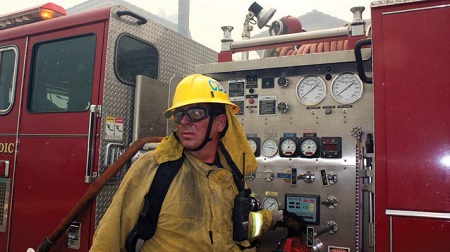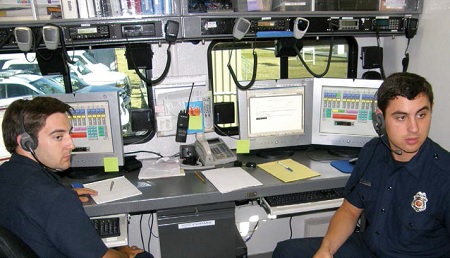Intercoms Beyond Broadcasting
SEATTLE—Fans of homeland security or military action adventure shows and movies see lots of folks wearing headsets, using intercom systems to communicate worldwide. Are these the same systems deployed in television stations, OB vans and entertainment venues? Yes and no.

The fire department in Carlsbad, Calif., uses Clear-Com intercoms for communications. “Broadcasting has its own set of unique requirements that the government [military , homeland security, first responders] don’t have, and vice versa,” said Corey Frasure, government solutions manager within Clear-Com’s Military, Aerospace, and Government (MAG) division. “[But] at the end of the day, we still use the same equipment.”
Doug Heinzen, regional marketing manager - North America, for InterCom and Dispatch at Bosch Security Systems Inc., echoes that. “Bosch as a corporation does not build military-specific products. If military does buy any products from us, they would have to be things that are commercial, off-the-shelf, with no special content or anything else involved.”
STRINGENT STANDARDS
That’s not to say that there are no differences in requirements between government customers and broadcast customers. Not surprising is that for government intercom users, security is much higher on the list. This is reflected in requirements that intercom traffic not be intercepted, and that it cannot be taken down and interrupted.
But quality of audio is no less important to the government side than it is to the broadcast side. “In military, homeland security and first responder situations, clear communications can be the difference between life and death,” said Christian Diehl, product manager at Riedel.
Intercom company associates who sell to broadcasters and those who sell on the government side often come from separate backgrounds, with those selling to broadcasters coming out of the audio industry, and those selling to the government having military or similar experience.
Get the TV Tech Newsletter
The professional video industry's #1 source for news, trends and product and tech information. Sign up below.
“Each market segment has its own unique challenges, its own jargon,” said Clear-com’s Frasure. “It is a difficult thing to deal with if you work on the commercial side and you try to go to the government side; they’re going to use terms that you’ll have no idea what they mean, and vice versa.”
Frasure comes from 21 years in the military. “I go to a TV station and they’re telling me all this stuff, and I don’t have any idea what they’re talking about.”
MIDDLE GROUND

First responders with the San Ramon (Calif.) Valley Fire District use the Telex C-Soft/IP-223 platform to coordinate radio communications in the field. There’s a middle ground of customers between government and broadcast that might be termed “industrial intercom” users. Gary Rosen, global sales manager at Pliant Technologies in Auburn, Ala., notes that “we do a very good business in the nuclear power industry, where they need reliable communications when refueling the plant, changing rods and that sort of thing.” He also pointed to the maritime industry, where Pliant’s radio communications systems are crucial for ships and oil rigs.
The different intercom vendors each point to strengths in their systems that make them attractive to the non-broadcast customer base.
Bosch’s Heinzen points to his company’s employment of industry-standard TCP/IP protocol, “[Some other systems] require either special routers or use a proprietary version of TCP/IP,” he said. “We work on industry standard TCP/IP. You can use standard switches and routers” from the IT industry.
He also points to his company’s large worldwide installed base of products and support network that makes replacement parts available around the globe.
Riedel’s Diehl touts his company’s audio quality. “Our two-wire beltpack-based solutions employ digital AES audio providing extremely high fidelity and none of the hums and buzzes associated with traditional analog intercoms,” he said. “Also, our Artist matrix intercom systems are linked together via fiber to provide the bandwidth, redundancies, protection from interception, and flexibility that is critical for government and military users. The simplicity of interfacing other systems into our intercom environments, such as radios, is key to creating complete communications solutions.”
Frasure says Clear-Com uses input from both market segments when developing new products.
“There are unique differences; maybe the government has a radio that it needs to connect to that you will never find on the commercial side, so custom cables have to be made,” he said. “But the radio interface itself stays the same for both commercial and for government.” Broadcast customers may benefit from a concept that is brought over from the government side, “and generally, one product gets built to serve both markets,” he said.
Pliant’s Rosen puts his company’s background in RF engineering forth as a top selling point. “Our RF is ultra-reliable, so, regardless of features, regardless of sound quality, regardless of size and weight…we spend a lot of time working on our RF architecture, so when people get connected they stay connected,” he said. “We have a redundant data signal, which means we send the data, and then we change frequencies and send the same data a second time. And that second send gives us, mathematically, a much better chance of full data recovery than if you’d only send the data once.”
So the long and short of it is that the government and broadcast customers may be buying the same intercom products, but for different reasons.
